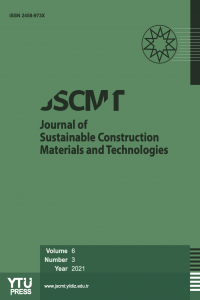Yüzeylere Uygulanan Antimikrobiyal Boyalar için Zaman Çizelgesi Yaklaşımı
İnsan tarafından inşa edilen yüzeylerde mikrobiyal üreme gezegensel bir sorundur. Kirlenmiş yüzeyler, özellikle halka açık yerlerde tehlikeli bulaşıcı hastalıkları hızla yayabilmektedir. Özellikle mevcut koşullar altında birkaç mikroorganizma kolayca milyonlara ulaşabilir. Hijyenik bir yüzey, mikro popülasyonların artışını engelleyen bir komponent olarak tanımlanmaktadır. Bu arada, antibakteriyel özellikleri ve bileşenleri üzerine yapılan araştırmalar gibi biyositlerin kullanımı da genişlemektedir. Şimdi piyasada çeşitli antimikrobiyal substratlar bulunmaktadır. Bu ürünlerin etkinliğini ve hassasiyetini araştırmak faydalı olacaktır. Bu makalede, antimikrobiyal olarak tanıtılan 6 farklı duvar boyası üzerinde bir deney yapılmış ve bakterilere karşı etkisi incelenmiştir. Ahşap paneller 6 farklı antimikrobiyal duvar boyası ile boyanmıştır. Dört farklı mikroorganizma steril bir püskürtme mekanizması kullanılarak yüzeye püskürtülmüştür. Çalışmada kullanılan bakteriler Escherichia coli, Listeria monocytogenes, Staphylococcus aureus, Bacillus subtilis'tir. Her bir panel doksan gün boyunca gözlemlenmiş ve sonuçlar tartışılmıştır.
Anahtar Kelimeler:
Escherichia Coli, Listeria Monocytogenes, Staphylococcus Aureus, Bacillus Subtilis, Antimikrobiyal boya, Yüzeyler
Timeline Approach for Antimicrobial Paints Applied on Surfaces
Microbial growth in man-made constructions is a planetary problem. Contaminated surfaces can rapidly spread dangerous infectious illnesses, especially in public places. A few microbes can quickly multiply into millions, especially under current circumstances. A hygienic sur- face is defined as a component that inhibits micro-population increase. Meanwhile, the use of biocides is expanding, as is research into their antibacterial characteristics and components. There are now various antimicrobial substrates on the market. It is worthwhile to investigate the efficacy and precision of these products. In this paper, an experiment has been made on six different wall paints, which are promoted as antimicrobials and are inspected against bacteria. Wooden panels were painted with six different antimicrobial wall paints. Four different microorganisms were sprayed on the surface using a sterile spraying mechanism. The bacteria used in the study were Escherichia coli, Listeria monocytogenes, Staphylococcus aureus, and Bacillus subtilis. Each panel was observed for ninety days, and the results were discussed. In contrast, the first paint proved effective on L. monocytogenes, S. aureus, and B. subtilis within the first two weeks and on E. coli within the first month. The second paint affected all four bacteria within the first month. The remaining paints proved ineffective until the third month's end.
Keywords:
Antimicrobial paint, Bacillus subtilis, Escherichia coli, Listeria monocytogenes; surfaces, Staphylococcus aureus,
___
- 1. Dearborn, D. G., Yike, I., Sorenson, W. G., Miller, M. J., & Etzel, R. A. (1999). Overview of investigations into pulmonary hemorrhage among infants in Cleveland, Ohio. Environmental Health Perspectives, 107, 495–499. [CrossRef]
- 2. Vesper, S., Dearborn, D. G., Yike, I., Allan, T., Sobolewski, J., Hinkley, S. F., Jarvis, B. B., & Haug- land, R. A. (2000). Evaluation of Stachybotrys chartarum in the house of an infant with pulmonary hemorrhage: quantitative assessment before, during, and after remediation. Journal of Urban Health: Bulletin of the New York Academy of Medicine, 77(1), 68–85. [CrossRef]
- 3. Pica, A., Guran, C., Andronescu, E., Oprea, O., Ficai, D., & Ficai, A. (2012). Antimicrobial performances of some film forming materials based on silver nanoparticles. Journal of Optoelectronics and Advanced Materials, 14(9), Article 863.
- 4. Hochmannova, L., & Vytrasova, J. (2010). Photocatalytic and antimicrobial effects of interior paints. Progress in Organic Coatings, 67(1), 1–5. [CrossRef]
- 5. Five Star Painting. What Is Antimicrobial Paint and Is It Safe for Your Home? (2023, January 13). https://www. fivestarpainting.com/blog/2022/june/what-is-anti- microbial-paint-and-is-it-safe-for-y/#:~:text=Anti- microbial%20paint%20is%20designed%20to,interi- or%20walls%20easier%20to%20clean.
- 6. Sianawati, E., Snyder, D., & Barrett L. (2007). Anti-microbial Coatings, Asia Pacific Coatings Show in Bangkok, June 6–8.
- 7. Vielkanowitz C. (2008). New silver based antimicrobial systems for hygiene coatings, in: American Coatings Conference, Charlotte, NC, June 2–4,
- 8. Baghdachi, J., Clemans, D. (2006). Formulation and evaluation of antimicrobial waterborne and high solids coatings, in: Smart Coatings Conference, Orlando, FL, February 15–17.
- 9. Johns, K. (2003). Hygienic coatings: The next generation. Surface Coatings International Part B: Coatings Transactions, 86(2), 101–110. [CrossRef]
- 10. Davidson, K., Moyer, B., Ramanathan, K., Preuss, A., & Pomper, B. (2007). Formulating coatings with silver-based antimicrobials: a systematic approach. JCT Coatingstech, 4(1), 56–62.
- 11. Hochmannova, L., & Vytrasova, J. (2010). Photocatalytic and antimicrobial effects of interior paints. Progress in Organic Coatings, 67(1), 1–5. [CrossRef]
- 12. Tiller, J. C. (2002). Pitture Vernici—European Coat- ings, 16, 37–39. [CrossRef]
- 13. Kumar, A., Vemula, P. K., Ajayan, P. M., & John, G. (2008). Silver-nanoparticle-embedded antimicrobial paints based on vegetable oil. Nature Materials, 7(3), 236–241. [CrossRef]
- 14. Katritzky, A. R., Ramsden, C. A., Scriven, E. F., & Taylor, R. J. (2008) Comprehensive heterocyclic chemistry III (14th ed.). Elsevier.
- 15. Collier, P. J., Ramsey, A. J., Austin, P., & Gilbert, P. (1990). Growth inhibitory and biocidal activity of some isothiazolone biocides. Journal of Applied Bacteriology, 69(4), 569–577. [CrossRef]
- 16. Shimizu, M., Shimazaki, T., Yoshida, T., Ando, W., & Konakahara, T. (2012). Synthesis of 1, 2-benziso- thiazolin-3-ones by ring transformation of 1, 3-ben- zoxathiin-4-one 1-oxides. Tetrahedron, 68(21), 3932–3936. [CrossRef]
- 17. Paulus, W. (Ed.). (2005). Directory of microbicides for the protection of materials: a handbook. Springer Science & Business Media. [CrossRef]
- 18. Collier, P. J., Ramsey, A., Waigh, R. D., Douglas, K. T., Austin, P., & Gilbert, P. (1990). Chemical reactivity of some isothiazolone biocides. Journal of Applied Bacteriology, 69(4), 578–584. [CrossRef]
- 19. Ayadi, M., & Martin, P. (1999). Pulpitis of the fingers from a shoe glue containing 1, 2‐benzisothiazolin‐3‐ one (BIT). Contact Dermatitis, 40(2), 115–116. [CrossRef]
- 20. Appendini, P., & Hotchkiss, J. H. (2002). Review of anantimicrobial food packaging. Innovative Food Science & Emerging Technologies, 3(2), 113–126. [CrossRef]
- Başlangıç: 2016
- Yayıncı: Yıldız Teknik Üniversitesi
Sayıdaki Diğer Makaleler
Bentonit Tabanlı Çinko Komplekslerin Sentezi ve Karakterizasyonu
Gülsüm Ece ANAVATAN, Elif ANT BURSALI, Mürüvvet YURDAKOÇ
Yüksek Dayanımlı Hafif Beton Paneller Kullanılarak Dolgulu Betonarme Çerçevelerin Güçlendirilmesi
Effects of Bamboo Leaf Ash on Alkali-Silica Reaction in Concrete
Catherine Mayowa IKUMAPAYI, Oluwaseun JEGEDE
Yüzeylere Uygulanan Antimikrobiyal Boyalar için Zaman Çizelgesi Yaklaşımı
Bakam Vision A, Mbimda Ali MBİSHİDA, Timothy DANJUMA
A Review on Blockchain Operations in Construction Management
